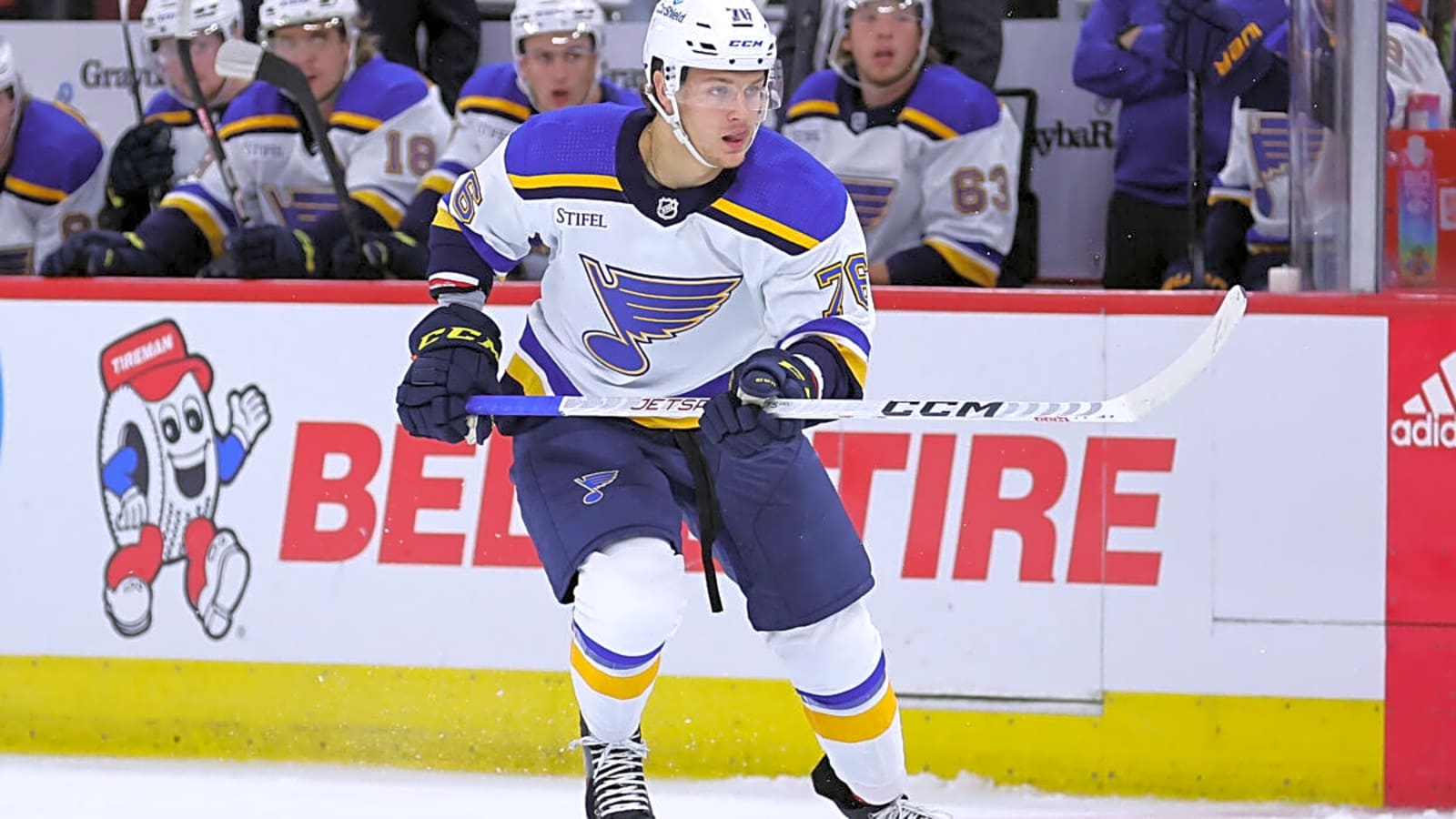
The St. Louis Blues made headlines on July 1, trading first-round pick Zachary Bolduc , who was selected 17th overall in the 2021 NHL Entry Draft, to the Montreal Canadiens for right-shot defenseman Logan Mailloux. The team’s organizational depth on the wing gave them the flexibility to part with Bolduc, especially to address a greater positional need on the blue line. While that reasoning holds weight, it also opens the door to an important question: Who fills Bolduc’s spot on the roster?
Assuming general manager (GM) Doug Armstrong refrains from making another seismic move that reshapes the team’s forward unit, the internal competition will be worth keeping an eye on.
The Blues have several viable options to consider—Mathieu Joseph, Oskar Sundqvist, Alexandre Texier, and Dalibor Dvorsky will have a chance to seize that opportunity. Each player brings a different skill set to the table, and with Armstrong’s offseason signaling a desire to return to playoff contention, the front office will decide who gives the team the best shot at winning now. This is not a developmental year—it’s about results, and the player who steps into Bolduc’s place must not only fill the void but push the team forward.
The Blues’ Veteran
Sundqvist, in many ways, embodies what it means to wear the Blue Note. His loyalty to the organization and his connection to the city are well-known—few players have embraced St. Louis the way he has, and the fans have returned that appreciation tenfold. He’s a grinder, a team-first player, and a respected voice in the locker room. His physicality, defensive awareness, and willingness to do the dirty work make him a valuable bottom-six option on any roster.
But this is a results-driven business. As much as heart and loyalty matter, the Blues are entering a critical season where internal competition and performance must take priority. So, does Sundqvist still give the team the best opportunity to win? While his veteran presence is undeniable, the Blues must weigh whether his skill set and production match the demands of a team vying for a playoff berth.
Based on last season, the answer is no. As the Blues’ third-line center, Sundqvist didn’t provide enough production to justify locking him into a consistent middle-six role. The likelihood of him rediscovering his offensive touch from five years ago feels increasingly slim; less a possibility and more like wishful thinking rooted in nostalgia. While his instincts and hockey IQ remain intact, the game has changed, and his age and accumulated wear have begun to affect his ability to keep up.
Sundqvist’s speed, once manageable, now lags behind the pace of play. His defensive reads haven’t necessarily deteriorated, but the physical toll of years spent battling in the dirty areas—net-front, corners, the boards—has left a mark. In today’s NHL, where speed and power often outweigh pure grit and positioning, that drop-off becomes a liability.
His game is still built on the fundamentals: dump-and-chase, hard forechecks, crashing the net. But in filling Bolduc’s vacancy—an offensive, high-ceiling role—Sundqvist’s skill set simply doesn’t align with the demands. He remains a valuable depth piece, a locker room leader, and a plug-in for tough matchups, but as a full-time solution to Bolduc’s departure? The fit just isn’t there.
As upsetting as it might be—for both fans and the player himself—Sundqvist’s role has diminished, and with it, so has his overall impact. At this stage in his career, any inclusion in the lineup would likely be the result of a roster shake-up rather than a performance-based decision. If he remains with the team, it would make more sense for him to slide into a fourth-line center role, with the ripple effect pushing Pius Suter to the wing and Nick Bjugstad into the center role on the third line. That configuration may offer lineup balance, but it doesn’t solve the long-term question left behind by Bolduc’s departure.
Sundqvist’s days of being a third-line regular need to be put to rest. While the loyalty and leadership are admirable—and still valuable in a limited capacity—the demands of that role in today’s NHL require speed, offensive pressure, and consistency, all of which are better filled by younger, more dynamic options in the system. It’s not an indictment of Sundqvist as a player or what he’s meant to the Blues; it’s simply the reality of a league that gets faster and more skilled with every passing year.
Two Blues Wild Cards
After a relatively encouraging showing during the Blues’ playoff series against the Winnipeg Jets, Joseph has emerged as one of the most commonly mentioned internal options to replace Bolduc. His name continues to surface, largely because of his complementary skill set and how well it could align with potential linemates Jake Neighbours and Suter. On paper, it’s a line that could bring speed, grit, and offensive depth—all key ingredients to a successful middle-six unit.
One of the Blues’ primary goals this offseason was to strengthen their center depth, particularly by finding players who could contribute more offensively down the middle. The addition of Suter addressed that need, giving them a reliable two-way center who can drive play and provide stability. The original plan was to roll out a third line featuring Neighbours, Suter, and Bolduc—a unit that showed flashes of becoming a dependable depth-scoring trio. With Bolduc now gone, however, the team must identify the right player to carry that momentum forward, and Joseph may be the best bet. His speed, offensive instincts, and ability to play at a high pace make him a natural fit alongside Neighbours’ physicality and Suter’s playmaking touch. While he may not replicate Bolduc’s pure scoring upside, Joseph’s versatility and energy could bring new life to the line—and perhaps even elevate it.
While Joseph brings speed and forechecking tenacity, Texier offers something rawer—pure offensive talent. He may not be the most responsible player in his own zone, and at times, he can be a defensive liability, but when the puck is on his stick, few internal candidates flash the same level of creativity, control, and dynamic skill. If the Blues are looking to replace Bolduc’s offensive ceiling rather than his two-way balance, Texier becomes an immediate contender for that open spot.
What makes Texier stand out is his ability to create plays in tight spaces, maintain possession under pressure, and generate offense from nothing. His vision and hands are exceptional, and when he’s engaged, he can be a nightmare for opposing defenders. He may not offer the defensive stability coaches often covet in a third-line role, but if deployed with the right linemates—particularly a defensively sound center like Suter—his weaknesses can be masked by the structure around him, allowing him to focus on what he does best: create scoring chances. With Neighbours adding grit and physicality, there’s a strong case to be made that Texier could slot in as a high-upside, offensively driven replacement that gives the Blues more punch from the third line.
Blues’ Youthful Prospect
Dvorsky, the Blues’ 10th overall pick in the 2023 NHL Entry Draft, has quickly become one of the organization’s most promising young players. After a dominant season in the Ontario Hockey League (OHL) with the Sudbury Wolves, where he posted an eye-popping 88 points in 52 games, Dvorsky made a smooth transition to professional hockey, earning time with the Springfield Thunderbirds and even suiting up for a few games with the Blues late last season. Now, following the Bolduc trade, there’s a legitimate opening for Dvorsky to seize consistent NHL minutes, particularly on the third line.

But with every promising opportunity comes a tough question about development. While Dvorsky has primarily played center throughout his career, the overwhelming consensus seems to lean toward easing him into the NHL by shifting him to the wing. Doing so would reduce the mental and positional burden that comes with playing down the middle at the highest level. It would also give him time to adjust to NHL speed and spacing while learning directly from veterans like Brayden Schenn, Robert Thomas, Suter and Bjugstad—four centers with strong faceoff ability and well-rounded games. It’s a smart, low-pressure way to allow Dvorsky to grow into his eventual role as a two-way center.
That said, there’s a very real drawback to this strategy: ice time. If Dvorsky makes the roster as a third-line winger, his minutes will likely fall to the 12–14 minute range, maybe a bit more with power play opportunities. Compare that to the 20-plus minutes per night he’d likely see in the American Hockey League (AHL), and you’re left with the age-old development question: What’s more valuable—playing fewer minutes at the highest level, or playing big minutes in a lower league? For a player with his ceiling, it’s a delicate balance. You want him challenged, but not buried. You want him contributing, but not stalled.
Still, the NHL experience—especially with the right linemates and coaching support—could be the catalyst that elevates his game. Given the Blues’ roster makeup, Dvorsky may represent the highest-upside option to step into Bolduc’s former role. Whether that’s best for his long-term trajectory depends entirely on usage, role clarity, and the organization’s willingness to let him grow through mistakes.
The Blues’ Best Option
The “best” option is always relative to what a team values most—development, experience, chemistry, or immediate results. But in this scenario, the objective is clear: win hockey games. When balancing both short-term needs and long-term potential, Dvorsky emerges as the most logical and impactful choice to replace Bolduc on the third line. His ceiling is higher than any of the other internal candidates, and his ability to learn and adapt will only come through consistent NHL exposure, not dominating a level he’s already outgrown.
Yes, there will be growing pains. A learning curve is inevitable. But development doesn’t happen in a vacuum, and keeping Dvorsky in Springfield risks stalling his progress more than nurturing it. In the AHL, he may be the focal point, but he won’t face the type of opposition, pace, or structure he will in the NHL. More importantly, he won’t be surrounded by the veteran leadership—players like Schenn, Bjugstad, and Thomas—who can help shape his professional habits on and off the ice. The opportunity to learn in real time, within a competitive roster, is something that can’t be replicated in a lower league.
The reality is the Blues are no longer in a rebuilding phase—they’re retooling on the fly. They pushed the Jets to a nail-biting Game 7 last postseason and showed signs that their young core is ready to compete. With that in mind, the window to ease players in is closing. Minutes won’t be easier to find as the team improves. So, if you’re going to commit to Dvorsky, now is the time—while there’s still enough breathing room to let him grow, make mistakes, and find his game at the NHL level.
Given the upside, the timing, and the current roster makeup, Dvorsky is the best option to take over Bolduc’s role. It’s a move that benefits the player, the team, and the future all at once. The Blues have made it clear they want to win—now it’s time to let one of their most promising young stars be a part of that journey.
More must-reads:
- Rickard Rakell undergoes surgery, to miss six to eight weeks
- Jets' Aaron Glenn praises Justin Fields for handling of awkward Woody Johnson situation
- The 'Active NFL receptions leaders' quiz
Breaking News
Trending News
Customize Your Newsletter
 +
+
Get the latest news and rumors, customized to your favorite sports and teams. Emailed daily. Always free!








